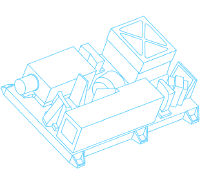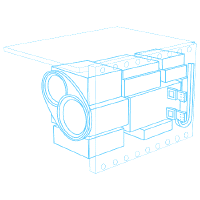French scientists and industry make major contribution to Mars Express
France is one of the major contributors to the Mars Express mission | |
|
|
Europe will make its debut in Mars exploration in June 2003 with the launch of Mars Express, the European Space Agency's orbiter and lander mission to the Red Planet. At least 25 companies from 15 European countries are building hardware or software for the spacecraft, or otherwise contributing their expertise; and more than 200 scientists from research institutes in all of ESA's member states and beyond are contributing towards the scientific payload.
"The Mars Express project is providing hundreds of jobs throughout Europe," estimates Rudi Schmidt, Mars Express project manager at ESTEC, the European Space Agency's technical centre in the Netherlands.
France is one of the major contributors to the mission. Astrium SAS in Toulouse is the prime contractor and French institutes are providing two of the seven scientific instruments that will fly around Mars on the orbiter. French scientists are co-investigators on most of the remaining instruments. The main French involvement is detailed below.
 SPICAM light
SPICAM light
SPICAM light: measuring water vapour in the atmosphere | |
|
|
Images returned by NASA's Mars Global Surveyor spacecraft last year show evidence of water seeping up to the Martian surface relatively recently. "We don't know when these features formed. It could have been 10 million years ago (which is recent in geological terms), three years ago, or even now," says Jean-Loup Bertaux from Service d'Aeronomie du CNRS, Verrières-le-Buisson, France. "The instrument we're building for Mars Express (SPICAM light) could help us find out by measuring the concentration of water vapour in the atmosphere." Any water seeping up to the surface of Mars now will evaporate almost instantly into the planet's thin atmosphere, causing an increase in the concentration of water vapour above the seepage area. "We'll be very careful about how we interpret the signal around these possible sites," says Bertaux.
SPICAM light is an ultraviolet and infrared spectrometer. It will determine the composition of the atmosphere from the wavelengths of sunlight that the constituent gases absorb. Over the mission lifetime, it will build up a map showing how the concentration of different gases varies over the entire planet. It will even be able to monitor the movement of some atmospheric constituents with the seasons.
 OMEGA
OMEGA
Over the lifetime of Mars Express, OMEGA, an infrared mineralogical mapping spectrometer, will produce a map of the mineral composition of the entire Martian surface. A few, selected areas will be mapped at higher resolution than the rest. "We'll target areas where previous missions have shown up something of particular interest, such as hydration, volcanic and impact features," says Jean-Pierre Bibring from the Institut d'Astrophysique Spatiale, Orsay, France.
OMEGA: mapping the mineral composition of the entire Martian surface | |
|
|
Like SPICAM, OMEGA will also contribute to an understanding of the fate of water on Mars. "Two of the big questions we have about Mars are: where is the carbon dioxide? and what happened to the water?" says Bibring. "There's carbon dioxide in the atmosphere, but the pressure's very low. So either Mars has lost its carbon dioxide, or it is now in the rocks in the form of carbonates. If the carbon dioxide is in the rocks, there must have been liquid water in the past." Carbonates form when carbon dioxide dissolves in water and then reacts with metals.
Mars Global Surveyor has identified many regions of layered rock, which could possibly be layers of sediment deposited on lake or ocean beds. OMEGA should be able to tell whether this is the case, or whether the layers were formed by other, possibly volcanic, means. "OMEGA will plot maps showing us where the most hydrated and the driest areas are, which could tell us where the water once was," says Bibring.
 Astrium, France, the prime contractor
Astrium, France, the prime contractor
With Mars Express, ESA is pioneering new, more economic ways of building space science missions. "Industry is more responsible in terms of the technical interfaces between instruments, spacecraft and launcher, which means we can have a more efficient decision-making process," says Vincent Poinsignon, Mars Express project manager at Astrium SAS.
As well as managing the building of the Mars Express spacecraft, Astrium SAS is also designing and testing the entire on-board software including the attitude and orbit control system. "We are subcontracting many of the sub-systems to 15-20 companies throughout Europe," says Poinsignon.
The spacecraft has recently completed mechanical tests at Intespace, Toulouse, one of the sub-contractors. The flight models of the instruments will be fitted later in the year.
For further information about Mars Express go to http://sci.esa.int/marsexpress/
 Media contacts
Media contacts
ESA Science Programme Communication Service
Tel: +31 71 565 3223
Fax: +31 71 565 4101
Rudolf Schmidt, ESA - Mars Express Project Manager
ESTEC - Noordwijk, The Netherlands
Tel: +31 71 565 3603
Email: Rudolf.Schmidt esa.int
esa.int
Agustin Chicarro, ESA - Mars Express Project Scientist
ESTEC - Noordwijk, The Netherlands
Tel: +31 71 565 3613
Email: Agustin.Chicarro esa.int
esa.int
Jean-Loup Bertaux, Principal Investigator SPICAM
Service d'Aeronomie du CNRS
BP 3 91371 - Verrieres le Buisson Cedex, France
Tel : +33 (0)1 64 47 42 51
Fax : +33 (0)1 69 20 29 99
Email: bertaux aerov.jussieu.fr
aerov.jussieu.fr
Jean-Pierre Bibring, Principal Investigator OMEGA
Institut d'Astrophysique Spatiale
Orsay, Paris, France
Tel: +33 (0)1 69 85 86 86
Email: bibring ias.u-psud.fr
ias.u-psud.fr
Vincent Poinsignon, Astrium - Mars Express Project Manager
Astrium
Toulouse, France
Tel: +33 (0)5 62 19 63 53
Email: Vincent.poinsignon astrium-space.com
astrium-space.com



